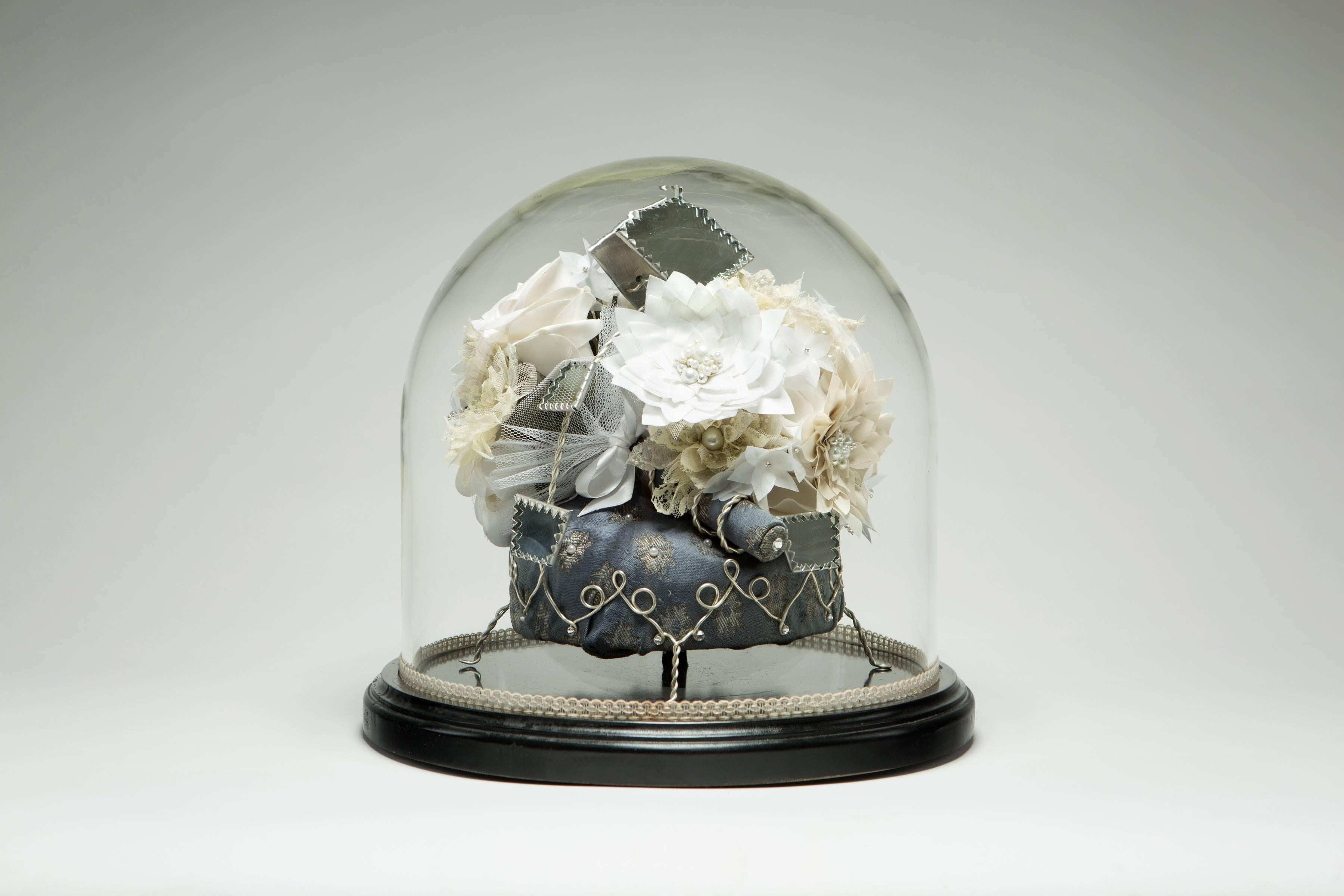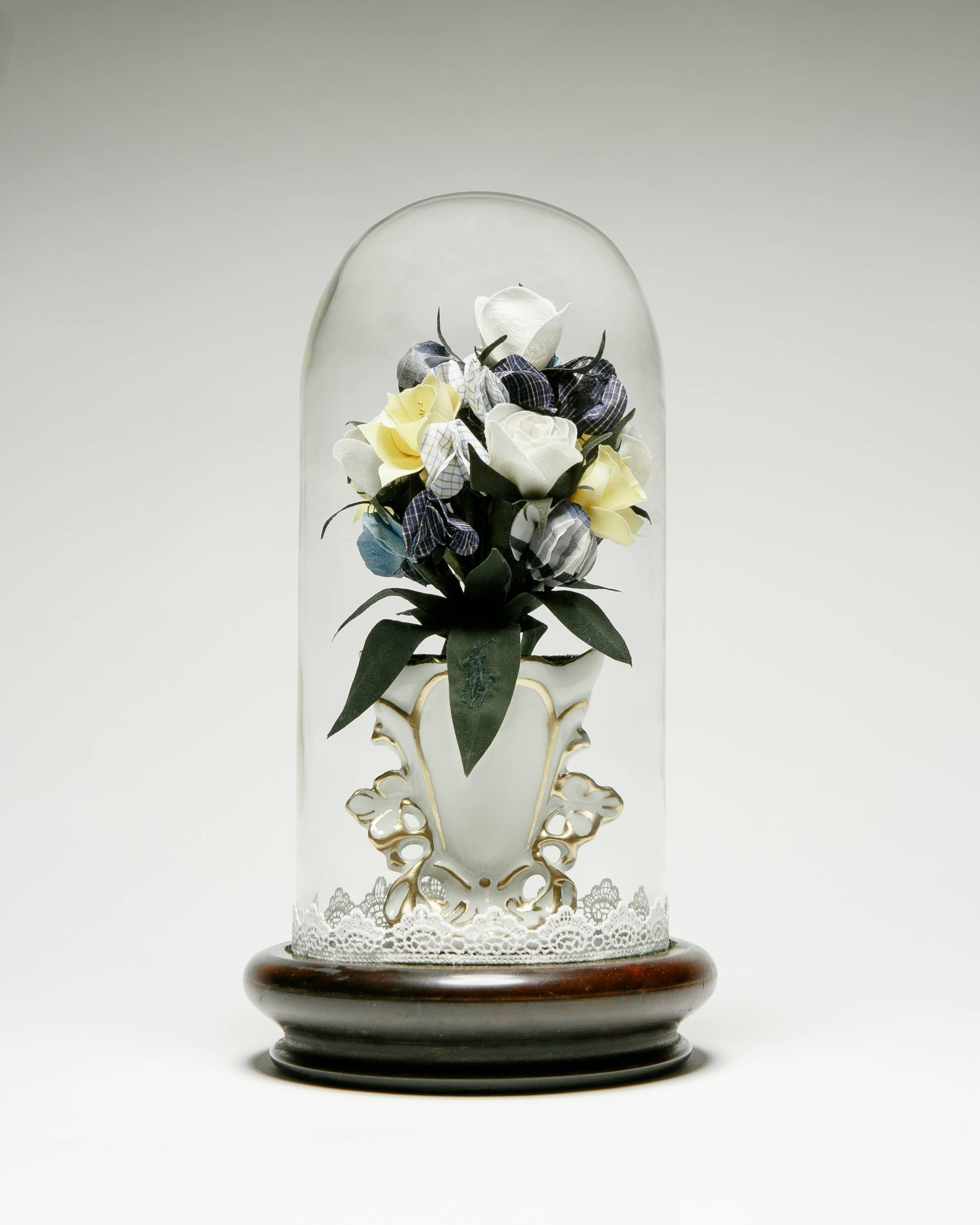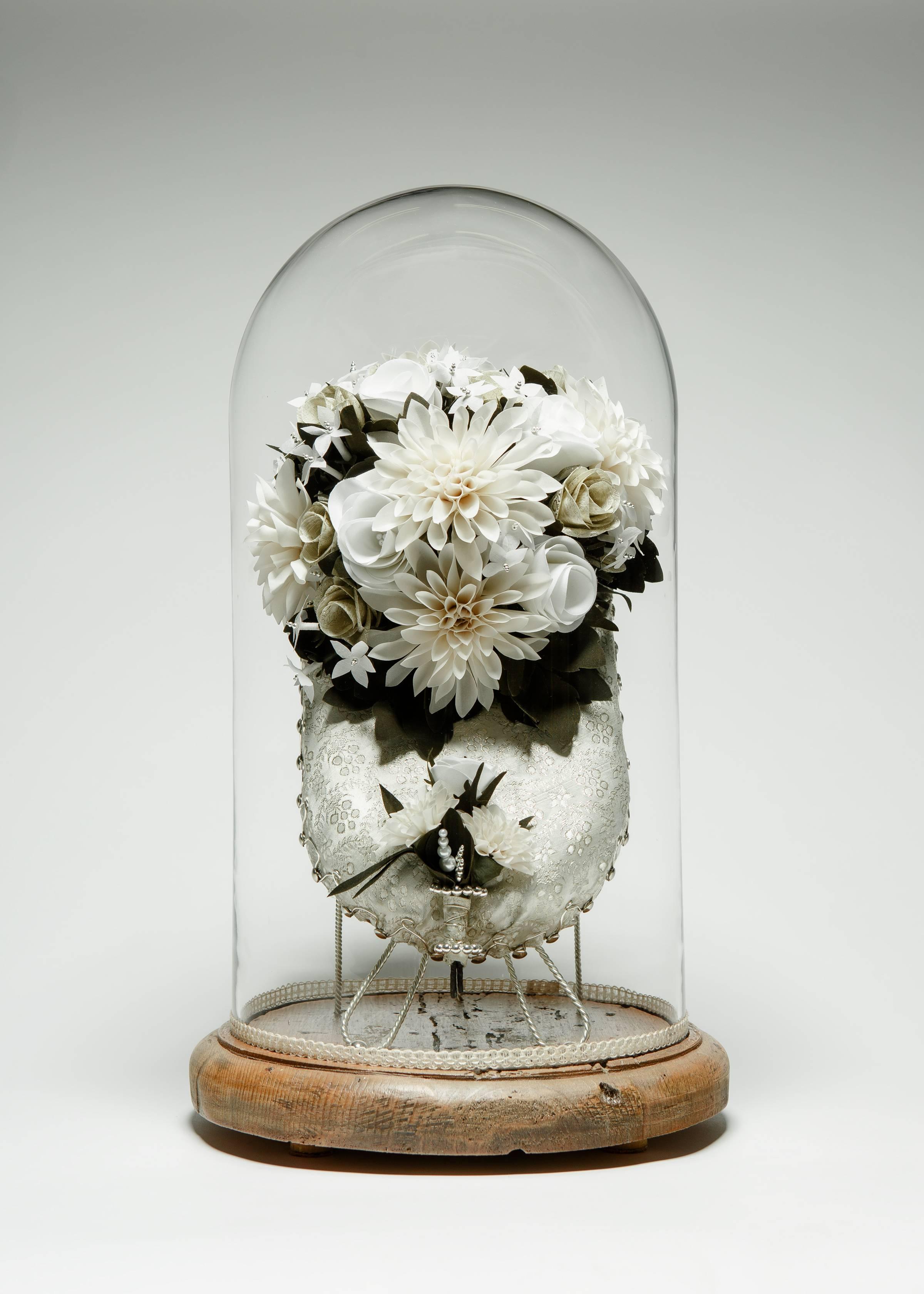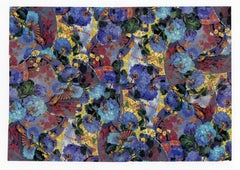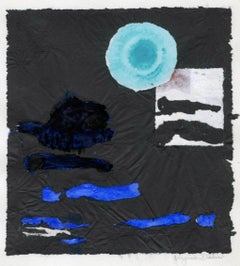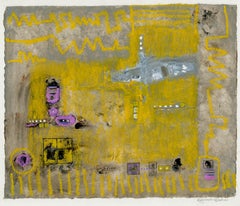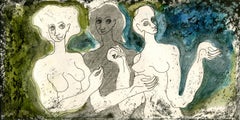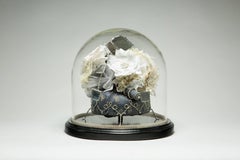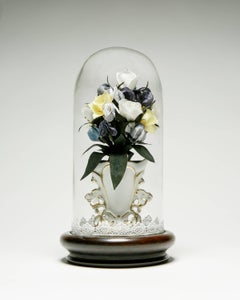Items Similar to Thelonius Monk- Little Rootie Tootie
Want more images or videos?
Request additional images or videos from the seller
1 of 5
Stephen LongstreetThelonius Monk- Little Rootie Tootie1989
1989
About the Item
Thelonius Monk- Little Rootie Tootie
Collage, 1989
Signed and dated lower right: "Longstreet 89"
Titled by artist lower left
Excellent, with usual imperfections associated with the collage medium
Image/Sheet size: 17 1/8 x 23 1/16 inches
Provenance: Acquired directly from the artist
Joseph M. Erdelac, Cleveland
Noted art collector and friend and aptron of
Longstreet.
Stephen Longstreet (1907-2002)
At the website, the artist’s own grandchildren attempt to fathom the real life and nature of Stephen Longstreet, prolific author, artist, screenplay writer, and jazz aficionado.
Born Chauncy Weiner (sometimes spelled Wiener) in New York City in 1907, Longstreet reinvented himself on a regular basis. Changing his name first to “Henry,” then “Henri,” he started his career as a commercial artist for a department store. In various public biographies he claimed to have studied in New York, London, and Paris, and said he was a student of cartoonist Ralph Barton (1891-1931). Facts that can be documented are that he was art editor for Golfer and Sportsman magazines, and was a contributor to various other magazines including The New Yorker, Saturday Evening Post, Colliers, Life, and Hooey, among others. He wrote sketches for NBC radio and the Rudy Vallee Show.
In the 1930s, Longstreet worked and wrote under the names Thomas Burton, David Ormsbee, and Paul Haggard before settling on the name Stephen Longstreet in 1939. He wrote 12 novels under this name as well as numerous screen plays, most notably The Jolson Story, The Greatest Show on Earth, and The Helen Morgan Story.
Longstreet claimed to have been introduced to ragtime and jazz by no less a legend than singer Paul Robeson while Robeson was an All-American football player at Rutgers University. However it happened, the world of jazz was a constant theme throughout Longstreet’s life. He drew and painted such notables as Count Basie, Sarah Vaughan, Billie Holiday, and Duke Ellington. His media included collage, watercolors, and ink drawings. In 1989 Longstreet published his 100th book, Jazz from A to Z: a Graphic Dictionary.
One of the more curious aspects of Longstreet’s art is his method of dating his material. He dated his works by the year depicted, not by the date of actual execution. Art signed “Longstreet” and dated before 1939 was actually done much later, as Stephen Longstreet did not exist prior to that! Early works from the late 1920s and 1930s will be signed “Henri” or “He” since Longstreet was still Weiner in those days. Later he often signed his work SL inside a circle. His collages dated in the 1950s or earlier were most likely done in the 1970s or 1980s.
Longstreet spent most of his life in the Los Angeles area with his wife and oft-times collaborator, Ethel Longstreet. The artist remained active and prolific into his 90s. He died in Los Angeles in 2002 at the age of 94.
Courtesy: StephenLongstreet
- Creator:
- Creation Year:1989
- Dimensions:Height: 17.125 in (43.5 cm)Width: 23.063 in (58.58 cm)
- Medium:
- Movement & Style:
- Period:
- Condition:Original.
- Gallery Location:Fairlawn, OH
- Reference Number:Seller: FA83191stDibs: LU14013571572
About the Seller
5.0
Recognized Seller
These prestigious sellers are industry leaders and represent the highest echelon for item quality and design.
Platinum Seller
Premium sellers with a 4.7+ rating and 24-hour response times
Established in 1978
1stDibs seller since 2013
784 sales on 1stDibs
Typical response time: 1 hour
Associations
International Fine Print Dealers Association
- ShippingRetrieving quote...Shipping from: Fairlawn , OH
- Return Policy
Authenticity Guarantee
In the unlikely event there’s an issue with an item’s authenticity, contact us within 1 year for a full refund. DetailsMoney-Back Guarantee
If your item is not as described, is damaged in transit, or does not arrive, contact us within 7 days for a full refund. Details24-Hour Cancellation
You have a 24-hour grace period in which to reconsider your purchase, with no questions asked.Vetted Professional Sellers
Our world-class sellers must adhere to strict standards for service and quality, maintaining the integrity of our listings.Price-Match Guarantee
If you find that a seller listed the same item for a lower price elsewhere, we’ll match it.Trusted Global Delivery
Our best-in-class carrier network provides specialized shipping options worldwide, including custom delivery.More From This Seller
View AllUntitled
By Peter Marks
Located in Fairlawn, OH
Untitled Abstraction
Unsigned
Mixed media, c. 2003-2004
Provenance:
Estate of the artist
Peter Marks (1935 -2010)
Peter Marks was born in New York City on January 18, 1935. A life...
Category
Early 2000s Contemporary Mixed Media
Materials
Mixed Media
Untitled
By Virginia Dehn
Located in Fairlawn, OH
Untitled
Mixed media with collage elements on paper, c. 1990's
Signed by the artist in pencil lower right (see photo)
Condition: Excellent
Image size: 7 x 6 1/2 inches
Support sheet size: 10 1/2 x 8 3/8 inches
Provenance: Estate of the artist
Dehn Heirs
Virginia Dehn
From Wikipedia, the free encyclopedia
Virginia Dehn
Virginia Dehn in her studio in Santa Fe
Virginia Dehn (née Engleman) (October 26, 1922 – July 28, 2005) was an American painter and printmaker. Her work was known for its interpretation of natural themes in almost abstract forms. She exhibited in shows and galleries throughout the U.S. Her paintings are included in many public collections.
Life
Dehn was born in Nevada, Missouri on October 26, 1922.] Raised in Hamden, Connecticut, she studied at Stephens College in Columbia, Missouri before moving to New York City. She met the artist Adolf Dehn while working at the Art Students League. They married in November 1947. The two artists worked side by side for many years, part of a group of artists who influenced the history of 20th century American art. Their Chelsea brownstone was a place where artists, writers, and intellectuals often gathered.
Early career
Virginia Dehn studied art at Stephens College in Missouri before continuing her art education at the Traphagen School of Design, and, later, the Art Students League, both located in New York City. In the mid-1940s while working at the Associated American Artists gallery, she met lithographer and watercolorist Adolf Dehn. Adolf was older than Virginia, and he already enjoyed a successful career as an artist. The two were married in 1947 in a private ceremony at Virginia's parents house in Wallingford, Connecticut.
Virginia and Adolf Dehn
The Dehns lived in a Chelsea brownstone on West 21st Street where they worked side by side. They often hosted gatherings of other influential artists and intellectuals of the 20th century. Among their closest friends were sculptor Federico Castellón and his wife Hilda; writer Sidney Alexander and his wife Frances; artists Sally and Milton Avery; Ferol and Bill Smith, also an artist; and Lily and Georges Schreiber, an artist and writer. Bob Steed and his wife Gittel, an anthropologist, were also good friends of the Dehns. According to friend Gretchen Marple Pracht, "Virginia was a glamorous and sophisticated hostess who welcomed visitors to their home and always invited a diverse crowd of guests..." Despite their active social life, the two were disciplined artists, working at their easels nearly daily and taking Saturdays to visit galleries and view new work.
The Dehns made annual trips to France to work on lithographs at the Atelier Desjobert in Paris. Virginia used a bamboo pen to draw directly on the stone for her lithographs, which often depicted trees or still lifes. The Dehns' other travels included visits to Key West, Colorado, Mexico, and countries such as Greece, Haiti, Afghanistan, and India.
Dehn's style of art differend greatly from that of her husband, though the two sometimes exhibited together. A friend of the couple remarked, "Adolf paints landscapes; Virginia paints inscapes." Virginia Dehn generally painted an interior vision based on her feelings for a subject, rather than a literal rendition of it.] Many of her paintings consist of several layers, with earlier layers showing through. She found inspiration in the Abstract Expressionism movement that dominated the New York and Paris art scenes in the 1950s. Some of her favorite artists included Adolf Gottileb, Rothko, William Baziotes, Pomodoro, and Antonio Tapies.
Dehn most often worked with bold, vibrant colors in large formats. Her subjects were not literal, but intuitive. She learned new techniques of lithography from her husband Adolf, and did her own prints. Texture was very important to her in her work. Her art was influenced by a variety of sources. In the late 1960s she came across a book that included photographs of organic patterns of life as revealed under a microscope. These images inspired her to change the direction of some of her paintings. Other influences on Dehn's art came from ancient and traditional arts of various cultures throughout the world, including Persian miniatures, illuminated manuscripts, Dutch still life painting, Asian art, ancient Egyptian artifacts...
Category
1990s Contemporary Mixed Media
Materials
Mixed Media
Untitled
By Virginia Dehn
Located in Fairlawn, OH
Untitled
Mixed media on paper mounted on paper, c. 1990's
Signed by the artist in pencil lower right (see photo)
Condition: Excellent
Image size: 8 5/8 x 10 1/4 inches
Support Sheet size: 11 1/4 x 12 3/4 inches
Provenance: Estate of the Artist
Dehn Heirs
Virginia Dehn
From Wikipedia, the free encyclopedia
Virginia Dehn
Virginia Dehn in her studio in Santa Fe
Virginia Dehn (née Engleman) (October 26, 1922 – July 28, 2005) was an American painter and printmaker. Her work was known for its interpretation of natural themes in almost abstract forms. She exhibited in shows and galleries throughout the U.S. Her paintings are included in many public collections.
Life
Dehn was born in Nevada, Missouri on October 26, 1922.] Raised in Hamden, Connecticut, she studied at Stephens College in Columbia, Missouri before moving to New York City. She met the artist Adolf Dehn while working at the Art Students League. They married in November 1947. The two artists worked side by side for many years, part of a group of artists who influenced the history of 20th century American art. Their Chelsea brownstone was a place where artists, writers, and intellectuals often gathered.
Early career
Virginia Dehn studied art at Stephens College in Missouri before continuing her art education at the Traphagen School of Design, and, later, the Art Students League, both located in New York City. In the mid-1940s while working at the Associated American Artists gallery, she met lithographer and watercolorist Adolf Dehn. Adolf was older than Virginia, and he already enjoyed a successful career as an artist. The two were married in 1947 in a private ceremony at Virginia's parents house in Wallingford, Connecticut.
Virginia and Adolf Dehn
The Dehns lived in a Chelsea brownstone on West 21st Street where they worked side by side. They often hosted gatherings of other influential artists and intellectuals of the 20th century. Among their closest friends were sculptor Federico Castellón and his wife Hilda; writer Sidney Alexander and his wife Frances; artists Sally and Milton Avery; Ferol and Bill Smith, also an artist; and Lily and Georges Schreiber, an artist and writer. Bob Steed and his wife Gittel, an anthropologist, were also good friends of the Dehns. According to friend Gretchen Marple Pracht, "Virginia was a glamorous and sophisticated hostess who welcomed visitors to their home and always invited a diverse crowd of guests..." Despite their active social life, the two were disciplined artists, working at their easels nearly daily and taking Saturdays to visit galleries and view new work.
The Dehns made annual trips to France to work on lithographs at the Atelier Desjobert in Paris. Virginia used a bamboo pen to draw directly on the stone for her lithographs, which often depicted trees or still lifes. The Dehns' other travels included visits to Key West, Colorado, Mexico, and countries such as Greece, Haiti, Afghanistan, and India.
Dehn's style of art differend greatly from that of her husband, though the two sometimes exhibited together. A friend of the couple remarked, "Adolf paints landscapes; Virginia paints inscapes." Virginia Dehn generally painted an interior vision based on her feelings for a subject, rather than a literal rendition of it.] Many of her paintings consist of several layers, with earlier layers showing through. She found inspiration in the Abstract Expressionism movement that dominated the New York and Paris art scenes in the 1950s. Some of her favorite artists included Adolf Gottileb, Rothko, William Baziotes, Pomodoro, and Antonio Tapies.
Dehn most often worked with bold, vibrant colors in large formats. Her subjects were not literal, but intuitive. She learned new techniques of lithography from her husband Adolf, and did her own prints. Texture was very important to her in her work. Her art was influenced by a variety of sources. In the late 1960s she came across a book that included photographs of organic patterns of life as revealed under a microscope. These images inspired her to change the direction of some of her paintings. Other influences on Dehn's art came from ancient and traditional arts of various cultures throughout the world, including Persian miniatures, illuminated manuscripts, Dutch still life painting, Asian art, ancient Egyptian artifacts...
Category
1990s Contemporary Mixed Media
Materials
Mixed Media
Title Unreadable “_______ _______ No. 102”
By Juan Velasquez Diaz
Located in Fairlawn, OH
Title Unreadable " _______ _______ No. 102"
Mixed media
Signed and dated lower right
Manuscript notes on black paper backing
Condition: Excellent
Image size: 6 1/2 x 12 3/4 inches
Bo...
Category
1960s Modern Mixed Media
Materials
Mixed Media
Untitled (Tuscan Landscape)
By Ray H. French
Located in Fairlawn, OH
Untitled (Tuscan Landscape)
Tissue paper collage on Fabriano support
Signed and dated lower right in ink
Provenance:
Estate of the artist
Martha A. French Trust
Created while the art...
Category
1960s American Modern Mixed Media
Materials
Mixed Media
Honoring the Pony Express (1860-1960)
By Norbert Lenz
Located in Fairlawn, OH
Signed in image lower left; Label verso #196
From Lenz's House of Farnam "First Day" Cover Series
Painter, illustrator and commercial artist Norbert Lenz was born in Norwalk, Ohio...
Category
20th Century Mixed Media
Materials
Mixed Media
You May Also Like
Globe de Mariée - Double Bouquet
By Carlton Scott Sturgill
Located in New Orleans, LA
Medium: vintage glass dome, wedding dresses and fabric, silver wire, mirrors, ribbon, floral tape, crystals and pearls
CARLTON SCOTT STURGILL received his Masters of Arts (Fine Art) from London’s Chelsea Collage of Art in Design in 2005, and his BA from the University of Cincinnati in 2002. Although he now lives outside of the Queen City, his work continues to be shaped by his Midwestern roots. His work has been exhibited in numerous galleries and museums in North America and Europe, including the Cornell Museum of Art in Delray Beach, Florida, Temple Bar Gallery in Dublin, Ireland, the Newhouse Center for Contemporary Art in New York City, as well as, PULSE Miami Beach Contemporary Art Fair and Art on Paper NYC. Sturgill currently lives and works in New Orleans, Louisiana.
The artist discusses the new body of work . . .
My grandmother was a quilt maker. Born in 1915 in Appalachia, her quilts weren’t made from anything that you would find at a Joann Fabric store. She took objects that had an existing function and gave them a new life. I grew up sleeping under a patchwork of her faded housedresses and my grandfather’s work-worn button-down shirts. Where others saw scraps of tattered fabric that had reached the end of their lifespan, my grandmother saw Ohio stars, Maltese crosses and other quilting patterns.
Tradition dictates an assumption of purpose, a prescribed path for everything that must be followed. Everything from work shirts to paint chip samples to wedding dresses have an agreed upon life arch. But an intervention, such as my grandmother’s, can give something a new purpose. A work shirt becomes a quilt, a paint chip sample becomes a mosaic, and a wedding dress becomes a bouquet of roses. The essence of the former purpose remains even as new characteristics are created, giving the objects a dual citizenship between what they were and what they have become.
Until recently the tradition of marriage had a prescribed path as well. One man and one woman joined together in a life-long monogamous union resulting in children, and until astonishingly recently, they needed to be of the same race and religion and from similar socioeconomic backgrounds. Many people believe that wedding traditions have been static for millennia, but like everything else it’s in a state of glacial evolution, punctuated by dramatic interventions that create revolutionary change. In our time of titanic shifts in the definition of marriage, many elements are being added, blending ancient and contemporary traditions to create something new.
My latest series of work, titled Something Old/Something New, examines the shifting notions of marriage by repurposing longstanding traditions into something more fitting for our current time. Secondhand wedding clothes are given a fresh start as roses, dahlias, and clematises. Paint chip samples are cut apart and spliced back together to spell out a couple’s longing for a non-conventional household. The French traditional of globe de mariée...
Category
2010s Contemporary Mixed Media
Materials
Mixed Media
Globe de Mariée - Nosegay Bouquet
By Carlton Scott Sturgill
Located in New Orleans, LA
Medium: vintage glass dome and wedding dresses, Antique French wedding vase, Ralph Lauren shirts, ribbon, floral tape
CARLTON SCOTT STURGILL received his Masters of Arts (Fine Art) from London’s Chelsea Collage of Art in Design in 2005, and his BA from the University of Cincinnati in 2002. Although he now lives outside of the Queen City, his work continues to be shaped by his Midwestern roots. His work has been exhibited in numerous galleries and museums in North America and Europe, including the Cornell Museum of Art in Delray Beach, Florida, Temple Bar Gallery in Dublin, Ireland, the Newhouse Center for Contemporary Art in New York City, as well as, PULSE Miami Beach Contemporary Art Fair and Art on Paper NYC. Sturgill currently lives and works in New Orleans, Louisiana.
The artist discusses the new body of work . . .
My grandmother was a quilt maker. Born in 1915 in Appalachia, her quilts weren’t made from anything that you would find at a Joann Fabric store. She took objects that had an existing function and gave them a new life. I grew up sleeping under a patchwork of her faded housedresses and my grandfather’s work-worn button-down shirts. Where others saw scraps of tattered fabric that had reached the end of their lifespan, my grandmother saw Ohio stars, Maltese crosses and other quilting patterns.
Tradition dictates an assumption of purpose, a prescribed path for everything that must be followed. Everything from work shirts to paint chip samples to wedding dresses have an agreed upon life arch. But an intervention, such as my grandmother’s, can give something a new purpose. A work shirt becomes a quilt, a paint chip sample becomes a mosaic, and a wedding dress becomes a bouquet of roses. The essence of the former purpose remains even as new characteristics are created, giving the objects a dual citizenship between what they were and what they have become.
Until recently the tradition of marriage had a prescribed path as well. One man and one woman joined together in a life-long monogamous union resulting in children, and until astonishingly recently, they needed to be of the same race and religion and from similar socioeconomic backgrounds. Many people believe that wedding traditions have been static for millennia, but like everything else it’s in a state of glacial evolution, punctuated by dramatic interventions that create revolutionary change. In our time of titanic shifts in the definition of marriage, many elements are being added, blending ancient and contemporary traditions to create something new.
My latest series of work, titled Something Old/Something New, examines the shifting notions of marriage by repurposing longstanding traditions into something more fitting for our current time. Secondhand wedding clothes are given a fresh start as roses, dahlias, and clematises. Paint chip samples are cut apart and spliced back together to spell out a couple’s longing for a non-conventional household. The French traditional of globe de mariée...
Category
2010s Contemporary Mixed Media
Materials
Mixed Media
Polly-romantic for long term/permanent - mw4w (denver)
By Carlton Scott Sturgill
Located in New Orleans, LA
Medium: paint chip sample mosaic on panel
CARLTON SCOTT STURGILL received his Masters of Arts (Fine Art) from London’s Chelsea Collage of Art in Design in 2005, and his BA from the University of Cincinnati in 2002. Although he now lives outside of the Queen City, his work continues to be shaped by his Midwestern roots. His work has been exhibited in numerous galleries and museums in North America and Europe, including the Cornell Museum of Art in Delray Beach, Florida, Temple Bar Gallery in Dublin, Ireland, the Newhouse Center for Contemporary Art in New York City, as well as, PULSE Miami Beach Contemporary Art Fair and Art on Paper NYC. Sturgill currently lives and works in New Orleans, Louisiana.
The artist discusses the new body of work . . .
My grandmother was a quilt maker. Born in 1915 in Appalachia, her quilts weren’t made from anything that you would find at a Joann Fabric store. She took objects that had an existing function and gave them a new life. I grew up sleeping under a patchwork of her faded housedresses and my grandfather’s work-worn button-down shirts. Where others saw scraps of tattered fabric that had reached the end of their lifespan, my grandmother saw Ohio stars, Maltese crosses and other quilting patterns.
Tradition dictates an assumption of purpose, a prescribed path for everything that must be followed. Everything from work shirts to paint chip samples to wedding dresses have an agreed upon life arch. But an intervention, such as my grandmother’s, can give something a new purpose. A work shirt becomes a quilt, a paint chip sample becomes a mosaic, and a wedding dress becomes a bouquet of roses. The essence of the former purpose remains even as new characteristics are created, giving the objects a dual citizenship between what they were and what they have become.
Until recently the tradition of marriage had a prescribed path as well. One man and one woman joined together in a life-long monogamous union resulting in children, and until astonishingly recently, they needed to be of the same race and religion and from similar socioeconomic backgrounds. Many people believe that wedding traditions have been static for millennia, but like everything else it’s in a state of glacial evolution, punctuated by dramatic interventions that create revolutionary change. In our time of titanic shifts in the definition of marriage, many elements are being added, blending ancient and contemporary traditions to create something new.
My latest series of work, titled Something Old/Something New, examines the shifting notions of marriage by repurposing longstanding traditions into something more fitting for our current time. Secondhand wedding clothes are given a fresh start as roses, dahlias, and clematises. Paint chip samples are cut apart and spliced back together to spell out a couple’s longing for a non-conventional household. The French traditional of globe de mariée...
Category
2010s Contemporary Mixed Media
Materials
Mixed Media
Seven Decorating Schemes (Shelf) - Modern
By Carlton Scott Sturgill
Located in New Orleans, LA
Medium: paint chip sample mosaics on panel, vintage mirror frames and shelf brackets, wood door frame
[New Orleans, LA ::: b.1971 - Cincinnati, OH]
Born in 1971 in Cincinnati, Ohio...
Category
21st Century and Contemporary Contemporary Mixed Media
Materials
Mixed Media
Globe de Mariée - Mixed Set
By Carlton Scott Sturgill
Located in New Orleans, LA
Medium: vintage glass dome, wedding dresses and fabric, Ralph Lauren shirts, barge wood, silver wire, ribbon, floral tape, crystals and faux pearls
CARLTON SCOTT STURGILL received his Masters of Arts (Fine Art) from London’s Chelsea Collage of Art in Design in 2005, and his BA from the University of Cincinnati in 2002. Although he now lives outside of the Queen City, his work continues to be shaped by his Midwestern roots. His work has been exhibited in numerous galleries and museums in North America and Europe, including the Cornell Museum of Art in Delray Beach, Florida, Temple Bar Gallery in Dublin, Ireland, the Newhouse Center for Contemporary Art in New York City, as well as, PULSE Miami Beach Contemporary Art Fair and Art on Paper NYC. Sturgill currently lives and works in New Orleans, Louisiana.
The artist discusses the new body of work . . .
My grandmother was a quilt maker. Born in 1915 in Appalachia, her quilts weren’t made from anything that you would find at a Joann Fabric store. She took objects that had an existing function and gave them a new life. I grew up sleeping under a patchwork of her faded housedresses and my grandfather’s work-worn button-down shirts. Where others saw scraps of tattered fabric that had reached the end of their lifespan, my grandmother saw Ohio stars, Maltese crosses and other quilting patterns.
Tradition dictates an assumption of purpose, a prescribed path for everything that must be followed. Everything from work shirts to paint chip samples to wedding dresses have an agreed upon life arch. But an intervention, such as my grandmother’s, can give something a new purpose. A work shirt becomes a quilt, a paint chip sample becomes a mosaic, and a wedding dress becomes a bouquet of roses. The essence of the former purpose remains even as new characteristics are created, giving the objects a dual citizenship between what they were and what they have become.
Until recently the tradition of marriage had a prescribed path as well. One man and one woman joined together in a life-long monogamous union resulting in children, and until astonishingly recently, they needed to be of the same race and religion and from similar socioeconomic backgrounds. Many people believe that wedding traditions have been static for millennia, but like everything else it’s in a state of glacial evolution, punctuated by dramatic interventions that create revolutionary change. In our time of titanic shifts in the definition of marriage, many elements are being added, blending ancient and contemporary traditions to create something new.
My latest series of work, titled Something Old/Something New, examines the shifting notions of marriage by repurposing longstanding traditions into something more fitting for our current time. Secondhand wedding clothes are given a fresh start as roses, dahlias, and clematises. Paint chip samples are cut apart and spliced back together to spell out a couple’s longing for a non-conventional household. The French traditional of globe de mariée...
Category
2010s Contemporary Mixed Media
Materials
Mixed Media
Tuxedo Clematis (Clematis tuxedis)
By Carlton Scott Sturgill
Located in New Orleans, LA
medium: secondhand tuxedos, tuxedo shirts, and Ralph Lauren shirts, faux pearls, wood, wire, PVC tubing, Duck Tape, floral tape
CARLTON SCOTT STURGILL received his Masters of Arts (...
Category
2010s Contemporary Mixed Media
Materials
Mixed Media
